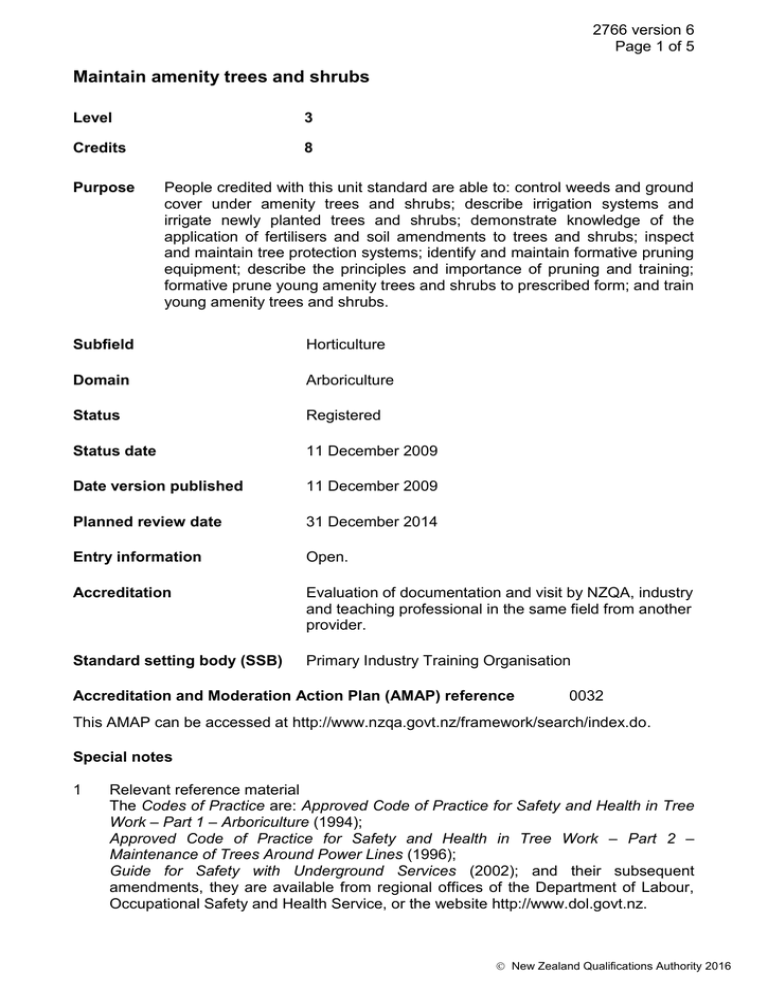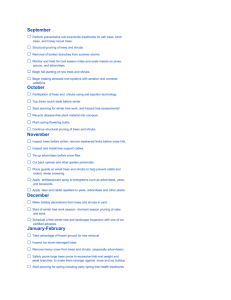Maintain amenity trees and shrubs
advertisement

2766 version 6 Page 1 of 5 Maintain amenity trees and shrubs Level 3 Credits 8 Purpose People credited with this unit standard are able to: control weeds and ground cover under amenity trees and shrubs; describe irrigation systems and irrigate newly planted trees and shrubs; demonstrate knowledge of the application of fertilisers and soil amendments to trees and shrubs; inspect and maintain tree protection systems; identify and maintain formative pruning equipment; describe the principles and importance of pruning and training; formative prune young amenity trees and shrubs to prescribed form; and train young amenity trees and shrubs. Subfield Horticulture Domain Arboriculture Status Registered Status date 11 December 2009 Date version published 11 December 2009 Planned review date 31 December 2014 Entry information Open. Accreditation Evaluation of documentation and visit by NZQA, industry and teaching professional in the same field from another provider. Standard setting body (SSB) Primary Industry Training Organisation Accreditation and Moderation Action Plan (AMAP) reference 0032 This AMAP can be accessed at http://www.nzqa.govt.nz/framework/search/index.do. Special notes 1 Relevant reference material The Codes of Practice are: Approved Code of Practice for Safety and Health in Tree Work – Part 1 – Arboriculture (1994); Approved Code of Practice for Safety and Health in Tree Work – Part 2 – Maintenance of Trees Around Power Lines (1996); Guide for Safety with Underground Services (2002); and their subsequent amendments, they are available from regional offices of the Department of Labour, Occupational Safety and Health Service, or the website http://www.dol.govt.nz. New Zealand Qualifications Authority 2016 2766 version 6 Page 2 of 5 The Standards are: BS 3998:1989 Recommendations for tree work; available from http://www.standardsuk.com; ANSI A300 Standards for Tree Care Operations (Parts 1 – 7) and their subsequent amendments, available from the website: http://www.isa-arbor.com. 2 Definition Workplace procedures refer to oral or written instructions to staff on procedures for the worksite and equipment. 3 Legislation relevant to this unit standard includes – Health and Safety in Employment Act 1992, Health and Safety in Employment Regulations 1995, Hazardous Substances and New Organisms Act 1996; and their subsequent amendments. Elements and performance criteria Element 1 Control weeds and ground cover under amenity trees and shrubs. Performance criteria 1.1 Weed control and ground cover options are compared in terms of their advantages and disadvantages for particular situations. Range mulches, plants, agrichemicals, cultivation. 1.2 Mulches and weed mats are applied and maintained so that weed growth is controlled. 1.3 Swards under amenity trees and shrubs are controlled in accordance with client specifications and workplace procedures. Range agrichemicals, mowing. 1.4 Ground cover plants are selected and spacing is recommended to optimise canopy under amenity trees and shrubs. 1.5 Tree surrounds are selected and installed for protection of trees and shrubs and for retention of mulch. Range evidence is required for one of – edgemasta, tree shelter, tree cage, grill, raised pavers, timber enclosure. Element 2 Describe irrigation systems and irrigate newly planted trees and shrubs. Performance criteria 2.1 Newly planted trees and shrubs are hand watered so that soil within the enclosure is brought to field capacity. New Zealand Qualifications Authority 2016 2766 version 6 Page 3 of 5 2.2 Manual and automatic irrigation systems are described in terms of their features, functions, and maintenance requirements. Range trickle, moveable sprinkler, fixed sprinkler including pop up types, soak hose, automatic timed, sensory system. Element 3 Demonstrate knowledge of the application of fertilisers and soil amendments to trees and shrubs. Performance criteria 3.1 Fertilisers and soil amendments are described in terms of their suitability for application to trees and shrubs. Range evidence is required for a minimum of five materials; descriptions include time of application, and manufacturer’s recommendations for rates and methods of application. Element 4 Inspect and maintain tree protection systems. Performance criteria 4.1 Stakes and ties are inspected, replaced and removed as required in accordance with workplace procedures. 4.2 Tree and shrub guards and surrounds are inspected, repaired, replaced and removed as required in accordance with workplace procedures. Range grates, guards, wind cloth, surrounds. Element 5 Identify and maintain formative pruning equipment. Range secateurs, pole loppers, loppers, pruning saw. Performance criteria 5.1 Pruning equipment is identified in terms of its suitability for a given task. 5.2 Equipment is cleaned, sharpened, repaired and oiled in accordance with manufacturers’ recommendations and workplace procedures. New Zealand Qualifications Authority 2016 2766 version 6 Page 4 of 5 Element 6 Describe the principles and importance of pruning and training. Performance criteria 6.1 The reasons for tree training and tree responses to training are described to show how final tree shape will be achieved. Range 6.2 espalier, hedging, multistem, pleaching, pollarding, single leader. The reasons for pruning and tree responses to pruning are described to show how final tree shape will be achieved. Range reasons – air circulation, health, light filtration, safety, statutory clearances, view. 6.3 Pruning is described in terms of the principle of maintaining a natural balance. 6.4 Natural target pruning is described in terms of using cut positions that promote desired plant responses. Element 7 Formative prune young amenity trees and shrubs to prescribed form. Performance criteria 7.1 Shape and structure are produced in accordance with the Standards. 7.2 Dead and diseased wood is removed in accordance with the Standards and workplace procedures. 7.3 Pruning meets client specifications. Element 8 Train young amenity trees and shrubs. Performance criteria 8.1 Trees are selected and trained into specified form without damage and in accordance with workplace procedures. Range 8.2 espalier, hedging, multistem, pleaching, pollarding, single leader. Root development is optimised through staking or support system. New Zealand Qualifications Authority 2016 2766 version 6 Page 5 of 5 Please note Providers must be accredited by NZQA, or an inter-institutional body with delegated authority for quality assurance, before they can report credits from assessment against unit standards or deliver courses of study leading to that assessment. Industry Training Organisations must be accredited by NZQA before they can register credits from assessment against unit standards. Accredited providers and Industry Training Organisations assessing against unit standards must engage with the moderation system that applies to those standards. Accreditation requirements and an outline of the moderation system that applies to this standard are outlined in the Accreditation and Moderation Action Plan (AMAP). The AMAP also includes useful information about special requirements for organisations wishing to develop education and training programmes, such as minimum qualifications for tutors and assessors, and special resource requirements. Comments on this unit standard Please contact the Primary Industry Training Organisation http://www.primaryito.ac.nz if you wish to suggest changes to the content of this unit standard. New Zealand Qualifications Authority 2016





